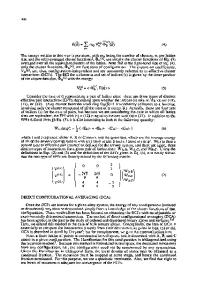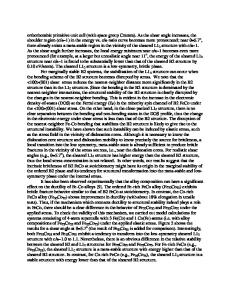Alloy Design of Ordered Intermetallics
- PDF / 3,433,710 Bytes
- 20 Pages / 420.48 x 639 pts Page_size
- 36 Downloads / 364 Views
ALLOY DESIGN OF ORDERED INTERMETALLICSt E. P. GEORGE
AND
C. T. LIU
Metals and Ceramics Division, Oak Ridge National Laboratory,Oak Ridge, TN 37831-6093
ABSTRACT Ordered intermetallics based on aluminides and silicides constitute a unique class of metallic materials possessing promising high-temperature properties. However, brittle fracture and poor ductility have limited their use as engineering materials in most cases. During the past ten years extensive research has been conducted on ordered intermetallics. As a result, significant progress has been made in identifying various causes of brittle fracture, and their relative importance in different ordered alloys. In some cases this understanding has helped achieve dramatic improvements in ductility. We review here three different classes of brittle fracture in ordered intermetallics and discuss the results in terms of model alloy systems chosen from each class. Ni3 AI and NiAl are discussed as prototypical ordered alloys prone to intrinsic intergranular brittleness. They are used to review our current understanding of intrinsically weak grain boundaries and the mechanisms by which boron is thought to suppress intergranular fracture. Next, FeAl and Fe3 AI are discussed as examples of ordered intermetallics that are susceptible to environmental embrittlement at ambient temperatures. Recent discoveries in these two alloy systems are reviewed with special emphasis on some of the rather interesting but subtle effects of test environment. Finally, A13 X type intermetallics (AI 3 Sc, Al 3Ti-base, and Al3 Zr-base alloys) are discussed as examples of ordered alloys that have high symmetry (L1 2 structure), are relatively soft, yet cleave transgranularly with very little ductility. In all these cases, experimental results are compared with theoretical calculations.
INTRODUCTION Poor ductility and brittle fracture are arguably the biggest drawbacks of the otherwise extremely attractive ordered intermetallic alloys. It is not surprising, therefore, that considerable attention has been focussed recently on understanding brittle fracture in intermetallics. In general, there are many possible causes of brittle fracture; it is only recently that we have begun to understand some of the basic micromechanisms and identify possible solutions. As a result, the field has seen a dramatic resurgence in interest during the past ten years [1-3]. Much of this recent interest is a direct result of the progress made during the late '70s in ductilizing ordered intermetallic alloys. For example, Liu [4,5] and Liu and Inouye [6] showed that it is possible to dramatically improve the ductility of Co 3 V (which has a low-symmetry hexagonal structure), by alloying with Fe and converting it into the higher-symmetry cubic L1 2 structure. Alloyinginduced improvements in ductility have been reported also in TiAl- and Ti 3AI-base alloys [7]. And, of course, we have seen the dramatic improvements in ductility that are possible when Ni 3AI is microalloyed with small amounts of boron [8,9]. What makes
Data Loading...











